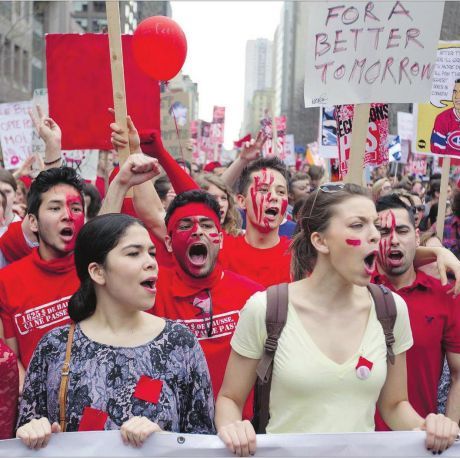Features
You are here
How Quebec students brought down a government

February 12, 2019
In 2012, students across Quebec launched a strike against a proposed massive tuition hike. The strike, which was the longest and most impressive in the history of Quebec and Canada, lasted over six months, from February to September.
Not only did it succeed in stopping the tuition hike, it sparked a mass movement that ultimately brought down the then-Liberal government of Jean Charest.
With growing struggle against attacks on post-secondary education in Ontario, activists are looking to the experience of Quebec students for inspiration and strategies. What are some of the lessons we can learn from the Quebec Spring?
Building from below
Quebec students showed that we can stop austerity measures, if we build resistance from below.
Threatened with a 75% tuition hike over five years, students mobilized all those opposed to the tuition hike within a broader argument against austerity.
The CLASSE student union did not suddenly call a strike from on high, but built it patiently from below—starting with mass petitions, demonstrations and protests. Through the process of organizing department by department and campus by campus, the movement built the rank-and-file confidence and experience necessary to organize and enforce a strike.
Polls coinciding with the strike’s launch in mid-February gave two-thirds support for Charest’s plan to increase tuition. The Liberals began to squeeze out right-wing Coalition Avenir Québec and creep up in the polls.
For nine weeks, Charest refused to sit down and talk with the student leaders. Amidst escalating police repression, it seemed clear to many that Charest was counting on populist anti-strike sentiment to give him a boost for the election, which some thought he would call for the spring.
Forging alliances
For six months students went on strike, resisting media vilification, sometimes extreme police violence, and government attempts to divide them at the negotiating table. The student movement built alliances with the climate justice and labour movements. In March, the CLASSE moved its general meeting to the town of Alma, where workers at Rio Tinto had been locked out for several months. This coincided with an international day of action to support the workers. They joined the workers’ march and called for the student strike to broaden into a social strike.
The students also joined the massive climate march on Earth Day in April, alongside hundreds of thousands of others. Their symbol, the red square (referring to students being squarely in the red) became ubiquitous.
Broadening the fight
The strike built and strengthened as more and more campuses voted to join. When the government responded to this success with a draconian law, bill 78—which banned gatherings of 50 people or more—the student movement called on all the population, whether students or not, to defend the right to protest and civil liberties more broadly.
The “casserole” protests built from small numbers of people gathering after work and banging pots in protest, to massive night-time marches that wound through the streets night after night. These protests were inspired by the movement against austerity in Argentina (‘cacerolazo’). They reached far beyond the student population and dug deep into Quebec society, effectively breaking the law in what became the largest act of civil disobedience in Canadian history. Solidarity demonstrations spread across Canada and around the world.
Electoral defeat
After months of increasingly broad protests, in a last desperate attempt to break the movement, Premier Charest called a provincial election. On September 4, the Quebec Liberals were tossed out of government. The next day, Charest resigned from politics after 28 years in office, having lost his own seat.
Ousting the Liberals was a huge victory for students and the left. Fed up with government corruption, declining social services, demonizing student protesters and criminalizing demonstrations, Quebecers had simply had enough.
The mass pressure from below pushed the newly elected Parti Québécois government to abolish the tuition hike and the law meant to enforce it. This, despite the PQ’s own history of tuition hikes in previous governments, and its earlier calls for people to comply with Bill 78.
Left alternative
While it was not long before the PQ began rolling out its own austerity program, the gains of the student strike were impressive and provide huge lessons for struggles today.
One of the lessons is how a left party can be a megaphone for the movement, and in the process build an alternative to the politics of austerity. At the time of the strike, Québec solidaire had only one elected MNA – Amir Khadir. He participated in the “illegal” demonstrations, was arrested and even had his home raided by police.
Québec solidaire operated to amplify the demands of the movement and build people’s confidence, before and during the election campaign.
In contrast, the PQ said ‘If you want to defeat Charest, you have to vote for us, whether you like our platform or not.’ This call by the PQ for ‘strategic voting’, i.e. telling people to vote against something rather than for something, was the opposite of QS which sought to be the party proposing positive changes, and not just replacing one government with another exactly the same.
Seven years later, QS has 10 MNAs elected on a clear left platform.
As we build the movement to stop Ford’s attacks, the lessons of the Quebec student strike caninspire and guide us.
Section:
Topics:










